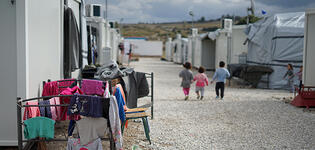Blog
Superpowers, super-spoilers, and hybrid warfare
What the new Cold War means for global cooperation
Last week we woke up to a conflict that had echoes of the Second World War, the Cold War, and the last two decades of hybrid conflict all mixed into one. It is difficult to look beyond the immediate suffering and scale of violations in Ukraine. Yet one important take-away so far from the means of warfare and political dynamics involved in the Ukraine crisis is that we are no longer in a post-Cold War era. Instead, we are in the throes of a new Cold War — one that is set to be as chilling for the prospects of international co-operation and conflict prevention as the last.
Different power dynamics
There had already been substantial warning signs of a new Cold War long before these recent cataclysmic events, and not just in terms of US-Russia or NATO-Russia competition. Strategic competition and great power rivalries have been the catchwords dominating international security and politics discussions for at least the last five years, if not well before that.
As tensions behind the US and China heated up over the course of 2021, there were pronouncements of a new US-China Cold War. USA President Biden even used his speech at the 76th Session of the General Assembly to decry the emergence of a new Cold War (although he then went on to essentially outline the ideological framework for it).
But while the tenor of the last few Security Council sessions and Russia’s nuclear saber-rattling have frightening echoes of the last Cold War, there are substantially different power dynamics, weapons, and tactics on display in this geopolitical competition. To begin, the main competitors are not the US and Russia, but rather the US and China. What places them in this position is not so much their disproportionate military power (although both have civilization-ending weapons at their disposal), but their disproportionate economic control.
The superpower here is weaponized interdependence, with the two countries uniquely positioned to exert hurting economic or political consequences by virtue of their dominance of key nodes and platforms in the global system. Economic sanctions, access to 5G platforms, trade routes and access are the carrots and sticks of inclusion or exclusion that allow the US and China to carve out competing spheres of influence.
A super-spoiler with global reach
Compared to the US and China, Russia appears less like a superpower than a super-spoiler, but one with a global reach. In the last decade in particular, it has leveraged its Soviet military-industrial legacy, expeditionary force projection, and talent for hybrid warfare to become a substantial player in conflicts across the Middle East and Africa.
That global military capacity — plus Russia’s ability to block Western efforts at sanctions through its Security Council veto — allows it to collect its own transactional allies and partners. The very recent voting on the UN draft resolutions condemning Russian aggression — both the recent Security Council vote and General Assembly vote— illustrate this. Only five countries voted with Russia, but the 35 abstentions in the General Assembly and three in the UN Security Council are more telling. The abstentions are a laundry list of countries recently saved from further UN censure by a Russian veto (Sudan, Mali, Central African Republic, South Sudan, and Congo) or who need Russia’s veto if controversial issues in their regions come before the Security Council (India and UAE).
Hybrid Cold War
What all this illustrates is that there are significantly different power dynamics at play in this new Cold War — of which the conflict in Ukraine is just one theater — and also substantial differences in the weapons and means of warfare that will define it. While all three countries still have substantial nuclear arsenals, the main terrain of competition and tactics being deployed represents a mixture of conventional and unconventional warfare, and of political and economic jockeying — a hybrid war.
The weapons and tactics on display in Ukraine are an example. Russia has combined deadly, but conventional aerial weapons and assault vehicles, with the more unconventional tactics of pre-positioned mercenary forces, support for pro-Russian separatists, and cyber-attacks. On the other side, Ukrainian resistance includes make-your-own Molotov cocktail sessions and other asymmetric tactics. Meanwhile, NATO countries have supported them with conventional arms support, counter-cyber hackers and counter-disinformation campaigns, and economic sanctions.
There are two distinct implications of a more hybrid Cold War — sadly both are negative. First, the more fluid and multi-faceted, but not all-powerful, nature of hybrid warfare may make it harder for deterrence to work. Although the level of sanctions applied to Russia have been unprecedented, they were not able to deter Russian aggression, and even after being deployed fully show little prospect of changing behaviour. The threat of mutually-hurting sanctions does not bear the same heft as Mutually Assured Destruction. The inability to reach any form of détente may result in less of a ‘Cold’ or frozen war than in the previous geopolitical standoff.
Second, given that the means of warfare have diversified across economic, technical, information, and other civilian spaces, war is as likely to be waged in our living rooms as in a far-away bunker or battlefield. It will also be fought in situations in which there is no prospect for ‘discriminate’ fighting and no way to avoid collateral damage.
Consequences for international co-operation
All of these dynamics are concerning, both for the violence unfolding daily in Ukraine and in terms of the prospects for global co-operation and conflict resolution in other arenas. With UN Security Council members swapping vetoes and caught in their own micro-aggressions on the side, it will be hard for the UN to play any role in addressing the many other conflicts and sources of violence that have accrued in the last two decades. The sort of concerted international co-operation necessary to address long-standing crises in places like Syria, Yemen, Afghanistan, and Myanmar, or to respond to emerging ones, like the string of coups and military conflicts across Africa recently, will be in short supply.
Perhaps the best that can be hoped for is that these differences prevent the sort of power consolidation that created the last Cold War. The stand taken in the UN General Assembly and the steps toward economic isolation — taken not just by the US and NATO allies but a range of other formerly neutral states and major corporations — are also encouraging. They signal a broader willingness to halt aggression and de-escalate this crisis that transcends ideological and geopolitical fault lines.
Dr Erica Gaston is the Senior Policy Advisor and Head of the Conflict Prevention and Sustaining Peace Programme at United Nations University Centre for Policy Research (UNU-CPR).
The views expressed in this piece are those of the author(s), and do not necessarily reflect the views of the Institute or the United Nations University, nor the programme/project donors.
 Join the network
Join the network












